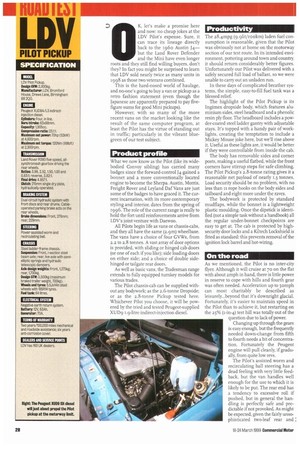0
Page 30

If you've noticed an error in this article please click here to report it so we can fix it.
and now: no cheap jokes at the LDV Pilot's expense. Sure, it can trace its lineage directly back to the 1960 Austin J4— but the Land Rover Defender and the Mini have even longer roots and they still find willing buyers, don't they? In fact you might be surprised to learn that LDV sold nearly twice as many units in 1998 as those two veterans combined.
This is the hard-nosed world of haulage, and no-one's going to buy a van or pickup as a retro fashion statement (even though the Japanese are apparently prepared to pay fivefigure sums for good Mini pickups).
However, with so many of the more recent vans on the market looking like the result of the same computer program, at least the Pilot has the virtue of standing out in traffic; particularly in the vibrant bluegreen of our test subject.
Product profile
What we now know as the Pilot (like its widebodied Convoy sibling) has carried many badges since the forward-control J4 gained a bonnet and a more conventionally located engine to become the Sherpa. Austin, Morris, Freight Rover and Leyland Daf Vans are just some of the badges to have graced it. The current incarnation, with its more contemporary styling and interior, dates from the spring of 1996. The role of the current range is really to hold the fort until reinforcements arrive from LDV's joint venture with Daewoo.
All Pilots begin life as vans or chassis-cabs, and they all have the same (2.9m) wheelbase. The vans have a choice of four GVWs, from 2.2 to 2,8 tonnes. A vast array of door options is provided, with sliding or hinged cab doors (or one of each if you like); side loading doors on either side; and a choice of double sidehinged or tailgate rear doors.
As well as basic vans, the Tradesman range extends to fully equipped turnkey models for various trades.
The Pilot chassis-cab can be supplied without any bodywork; as the 2.6-tonne Dropside; or as the 2.8-tonne Pickup tested here. Whichever Pilot you choose, it will be powered by the tried and tested Peugeot-supplied XUD9 1.9-litre indirect-injection diesel.
Productivity
The 28.4mpg (9.91itfrookm) laden fuel con sumption is reasonable, given that the Pilot was obviously not at home on the motorway section of our test route. In its intended environment, pottering around town and country, it should return considerably better figures. Unfortunately our Pilot was delivered with a safely secured full load of ballast, so we were unable to carry out an unladen run.
In these days of complicated breather systems, the simple, easy-to-fill fuel tank was a blessed relief.
The highlight of the Pilot Pickup is its Ingimex dropside body, which features aluminium sides, steel headboard and a phenolic resin ply floor. The headboard includes a powder-coated steel 'ladder gantry with adjustable stays. It's topped with a handy pair of worklights, creating the temptation to include a Mickey Mouse joke here, but we'll rise above it. Useful as these lights are, it would be better if they were controllable from inside the cab.
The body has removable sides and corner posts, making a useful flatbed, while the front corners have stirrup steps for safe climbing. The Pilot Pickup's 2.8-tonne rating gives it a reasonable net payload of nearly 1.3 tonnes. Load security should be no problem, with no less than ii rope hooks on the body sides and tailboard and eight more under the raves.
The bodywork is protected by standard mudflaps, while the bonnet is a lightweight plastic moulding. Once the dipstick is identified (not a simple task without a handbook) all the regular under-bonnet checkpoints are easy to get at. The cab is protected by highsecurity door locks and a Kiltech Lockshield is fitted as standard: this prevents removal of the ignition lock barrel and hot-wiring.
On the road
As we mentioned, the Pilot is no inter-city flyer. Although it will cruise at 70 on the flat with about 2mph in hand, there is little power in reserve to cope with hills and fourth gear was often needed. Acceleration up to 50mph can most charitably be described as leisurely...beyond that it's downright glacial. Fortunately, it's easier to maintain speed in the Pilot than to achieve it, but restarting on the 25% (I-in-4) test hill was totally out of the question due to lack of power.
Changing up through the gears is easy enough, but the frequently needed down-change from fifth to fourth needs a bit of concentration. Fortunately the Peugeot engine will pull cleanly, if gradually, from quite low revs.
The Pilot's assisted worm and recirculating ball steering has a dead feeling with very little feedback, but the van handles well enough for the use to which it is likely to be put. The rear end has a tendency to excessive roll if pushed, but in general the handling is perfectly safe and predictable if not provoked. As might be expected, given the fairly unsophisticated two-leaf rear and




















































































































